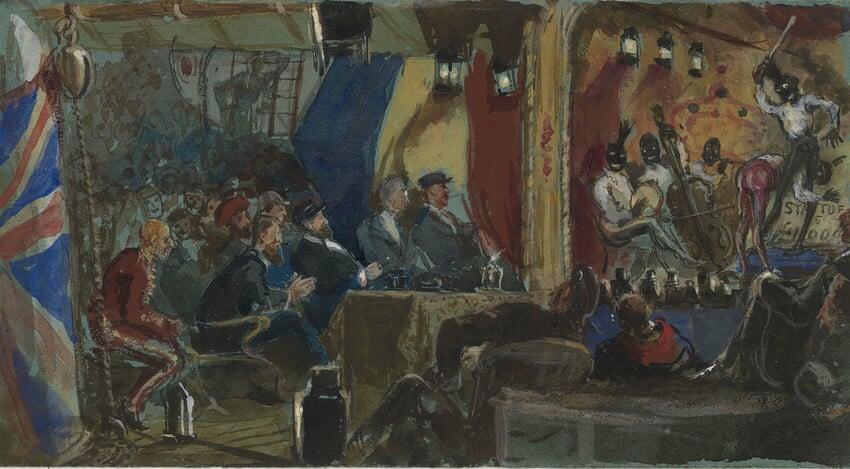-
1 of 253523 objects
A performance on board HMS Serapis 21 Oct 1875
Watercolour, bodycolour and gum arabic | 10.2 x 18.6 cm (whole object) | RCIN 923277

Sydney Prior Hall (1842-1922)
A performance on board HMS Serapis 21 Oct 1875
-
A watercolour and bodycolour drawing with gum arabic showing a performance on board HMS Serapis, 21 October 1875.
The drawing shows a performance of minstrels in 'blackface', today considered highly derogatory. Blackface Minstrel shows were popular during the mid-nineteenth and early twentieth century in Europe and the United States. Its popularity in England can be seen in 1882, when the Prince of Wales received banjo lessons from James Bohee, an African-American performer (see Laura Vorachek, 'Whitewashing Blackface Minstrelsy in Nineteenth Century England: Female Banjo Players in Punch', Victorians, A Journal of Culture and Literature, Issue 123, Spring 2013, pp. 31-51). A photograph of the same performance in the Royal Collection is RCIN 2701573. The performance was also described to Queen Victoria by Canon Duckworth as 'a company of the sailors & marines who extemporized a very amusing entertainment in the style of "Christy Minstrels" (Royal Archives, WRA Z468/79/25 October 1875).
In October 1875, Albert Edward, Prince of Wales, the eldest son of Queen Victoria and Prince Albert and later King Edward VII (r.1901-10), embarked on an extensive tour of the Indian subcontinent, travelling on HMS Serapis. The Prince of Wales visited more than 21 towns and cities across parts of modern-day India, Sri Lanka, Pakistan and Nepal before returning to England in May 1876. Albert Edward’s tour of India was envisaged as a way of forging diplomatic links between the Indian rulers and the British Crown. The tour was extensively covered in the British press pictorially as well as in the form of descriptive accounts of the royal engagements undertaken by Albert Edward and the entertainments and activities he enjoyed. Though there were controversies before the tour began about its expense and purpose, ultimately from the British perspective it was considered successful and the prince received a warm reception in the places he visited. The response on the Indian subcontinent to Albert Edward's tour, and what it symbolised in terms of imperial rule and colonial relations, was more mixed.
Sydney Prior Hall was a draughtsman and illustrator who worked for the Graphic newspaper, as well as a portrait painter. He was invited to accompany the tour of India made by the Prince of Wales as Special Artist, and his watercolours of India were exhibited in 1876 at the South Kensington Museum along with some of the gifts given to Albert Edward. Many of the drawings Hall made during the tour were also reproduced as illustrations to The Prince of Wales's Tour. A Diary in India (1877) by William Russell, a reporter for The Times newspaper who travelled with the prince to India in the capacity of his Honourable Private Secretary. This drawing was reproduced on pp. 42-3 with a description. Sydney Prior Hall maintained a friendship with the prince after the tour, and Albert Edward often visited his studio in London.Provenance
Acquired by King Edward VII when Albert Edward, Prince of Wales
-
Creator(s)
-
Medium and techniques
Watercolour, bodycolour and gum arabic
Measurements
10.2 x 18.6 cm (whole object)
Other number(s)
RL 23277